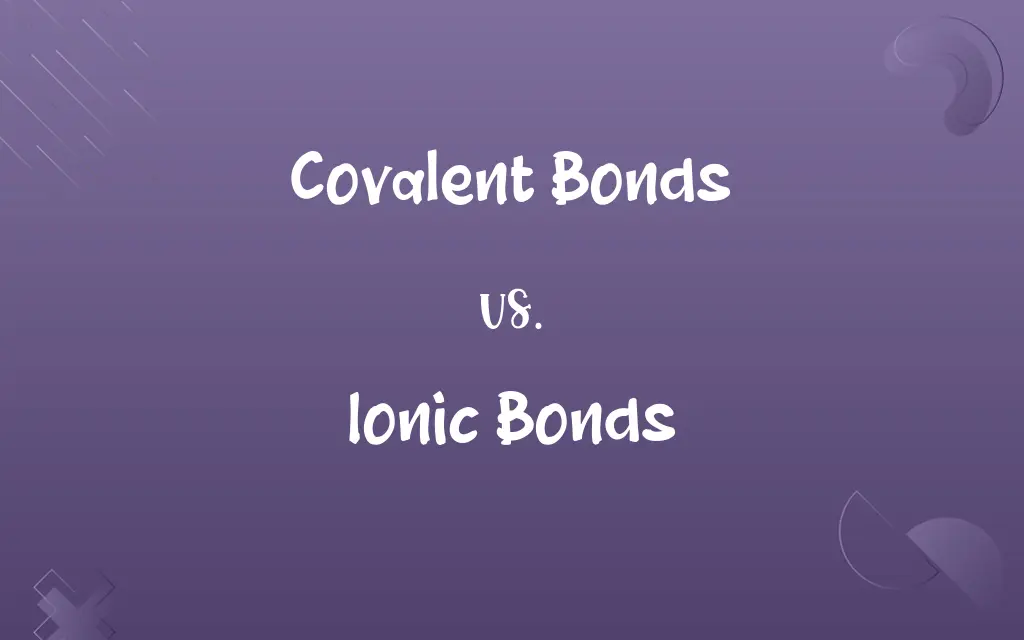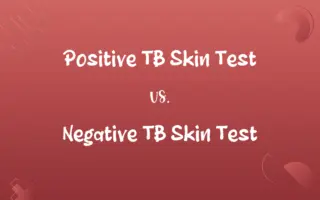Covalent Bonds vs. Ionic Bonds: Know the Difference

By Shumaila Saeed || Updated on December 25, 2023
Covalent bonds involve the sharing of electron pairs between atoms, while ionic bonds involve the transfer of electrons from one atom to another.

Key Differences
Covalent bonds form when two atoms share one or more pairs of electrons, creating a strong bond that holds the atoms together. In contrast, ionic bonds occur when one atom donates an electron to another atom, resulting in a bond formed due to the electrostatic attraction between the oppositely charged ions.
Shumaila Saeed
Dec 11, 2023
Covalent bonding typically occurs between non-metal atoms with similar electronegativities, which leads to a stable balance of attractive and repulsive forces. Ionic bonds, however, usually form between metal and non-metal atoms, where one atom has a much higher electronegativity than the other, leading to electron transfer.
Shumaila Saeed
Dec 11, 2023
In covalent bonds, the shared electrons occupy the space between the atoms, leading to a definitive molecular structure. Ionic bonds, on the other hand, produce a crystalline lattice where ions are held in a rigid, repeating pattern.
Shumaila Saeed
Dec 11, 2023
Covalent compounds tend to have lower melting and boiling points compared to ionic compounds, owing to the weaker intermolecular forces in covalent compounds. Ionic compounds exhibit higher melting and boiling points due to the strong electrostatic forces between the ions.
Shumaila Saeed
Dec 11, 2023
Covalent bonds often result in the formation of molecules with specific shapes, like water (H2O) or methane (CH4), based on the shared electrons. Ionic bonds create compounds like sodium chloride (NaCl), where the ratio of ions gives the compound its chemical properties.
Shumaila Saeed
Dec 11, 2023
ADVERTISEMENT
Comparison Chart
ADVERTISEMENT
Covalent Bonds and Ionic Bonds Definitions
Covalent Bonds
Covalent bonds involve the sharing of electrons between atoms.
The oxygen and hydrogen atoms in water molecules are held together by covalent bonds.
Shumaila Saeed
Dec 03, 2023
Ionic Bonds
Ionic bonds are formed by the electrostatic attraction between positively and negatively charged ions.
Table salt, or sodium chloride, is held together by ionic bonds.
Shumaila Saeed
Dec 03, 2023
Covalent Bonds
Covalent bonds create molecules with a specific geometric shape.
Methane has a tetrahedral shape due to its covalent bonds.
Shumaila Saeed
Dec 03, 2023
Ionic Bonds
Ionic bonds produce crystalline structures in solid form.
The crystal structure of sodium chloride is due to its ionic bonds.
Shumaila Saeed
Dec 03, 2023
Covalent Bonds
Covalent bonds can be single, double, or triple, based on the number of shared electron pairs.
The nitrogen molecules in the air consist of a triple covalent bond.
Shumaila Saeed
Dec 03, 2023
ADVERTISEMENT
Ionic Bonds
Ionic bonds occur between metals and non-metals.
Calcium chloride forms from ionic bonds between calcium and chlorine atoms.
Shumaila Saeed
Dec 03, 2023
Covalent Bonds
Covalent bonds typically form between non-metal atoms.
The carbon atoms in diamond are held together by covalent bonds.
Shumaila Saeed
Dec 03, 2023
Ionic Bonds
Ionic bonds involve the complete transfer of electrons from one atom to another.
In potassium fluoride, an ionic bond is formed by the transfer of an electron from potassium to fluorine.
Shumaila Saeed
Dec 03, 2023
Covalent Bonds
Covalent bonds result in the formation of molecules or networks.
Graphite is composed of layers of carbon atoms held together by covalent bonds.
Shumaila Saeed
Dec 03, 2023
Ionic Bonds
Ionic compounds have high melting and boiling points.
Magnesium oxide has a high melting point due to its strong ionic bonds.
Shumaila Saeed
Dec 03, 2023
Repeatedly Asked Queries
What is a covalent bond?
A chemical bond where two atoms share electron pairs.
Shumaila Saeed
Dec 11, 2023
Are covalent bonds strong?
Yes, they are generally strong, especially in molecular forms.
Shumaila Saeed
Dec 11, 2023
Can covalent bonds conduct electricity?
No, they generally do not conduct electricity.
Shumaila Saeed
Dec 11, 2023
Do ionic bonds form crystals?
Yes, ionic bonds typically form crystalline structures.
Shumaila Saeed
Dec 11, 2023
What is an ionic bond?
A chemical bond formed by the transfer of electrons between atoms.
Shumaila Saeed
Dec 11, 2023
Are covalent bonds found in all states of matter?
Yes, they are found in gases, liquids, and solids.
Shumaila Saeed
Dec 11, 2023
Is water soluble in covalent compounds?
It depends on the compound's polarity.
Shumaila Saeed
Dec 11, 2023
Do ionic compounds conduct electricity?
Yes, when dissolved in water or melted.
Shumaila Saeed
Dec 11, 2023
Are ionic bonds directional like covalent bonds?
No, they are non-directional, attracting ions in all directions.
Shumaila Saeed
Dec 11, 2023
Do covalent bonds require high energy to break?
Yes, they generally require significant energy to break.
Shumaila Saeed
Dec 11, 2023
Are ionic bonds found in organic compounds?
Rarely, they are mostly found in inorganic compounds.
Shumaila Saeed
Dec 11, 2023
What affects the strength of a covalent bond?
The number of shared electrons and the distance between nuclei.
Shumaila Saeed
Dec 11, 2023
What affects the strength of an ionic bond?
The charge of the ions and the size of the ions.
Shumaila Saeed
Dec 11, 2023
Do ionic bonds dissolve in nonpolar solvents?
No, they typically dissolve in polar solvents.
Shumaila Saeed
Dec 11, 2023
Do ionic bonds form molecules?
No, they form crystal lattices, not individual molecules.
Shumaila Saeed
Dec 11, 2023
Can covalent bonds form between more than two atoms?
Yes, in complex molecules.
Shumaila Saeed
Dec 11, 2023
Share this page
Link for your blog / website
HTML
Link to share via messenger
About Author
Written by
Shumaila SaeedShumaila Saeed, an expert content creator with 6 years of experience, specializes in distilling complex topics into easily digestible comparisons, shining a light on the nuances that both inform and educate readers with clarity and accuracy.









































































